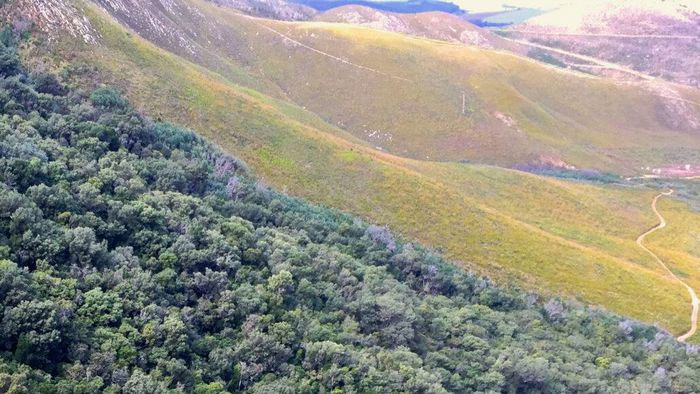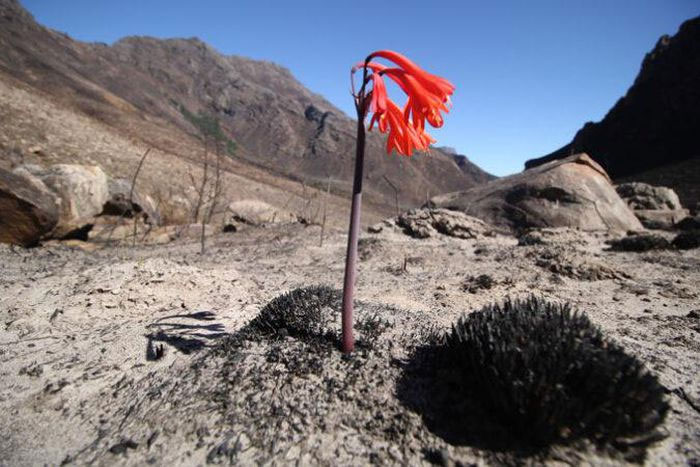Fynbos is a unique type of shrubland found exclusively in the southernmost part of Africa, boasting the thinnest root systems compared to any other plant community in the world to date. These nutrient-hungry roots, along with certain adaptive capabilities, have transformed the areas where only fynbos plants can survive into a harsh world.
In South Africa, you can move from a lush green forest to a sun-drenched shrubland in just a single step. New research shows that these narrow borders between significantly different ecosystems are maintained by fierce competition among the root systems of the plants.

The fynbos shrubland of South Africa (background) abruptly transitions to lush forest (foreground), a stalemate maintained by the super-thin root system of fynbos.
Interested in the natural organizational factors on a very large scale, ecologist Lars Hedin and his colleagues wanted to examine places where environmental changes over time could flip ecosystems between two distinct states.
The fynbos land is a low, shrub-rich habitat with astonishing plant diversity: over 7,000 species, most of which are not found anywhere else in the world.
Hedin, from Princeton University, stated: “It is one of the most biodiverse systems in the world. Essentially, it is as diverse as a tropical rainforest.”
But right next to this floral paradise – with the same climate and basic geological composition – is the lush temperate forest of Africa, thriving with tall trees and moss, but generally with fewer species.
“The boundary is as sharp as one meter. It’s like a binary switch, not a transition,” said co-author Mingzhen Lu, an ecologist at the Santa Fe Institute in New Mexico. He noted that this area is much narrower than the transition zone between savanna and tropical rainforest, which can occur over several kilometers.
To investigate what underlies these sharp boundaries, the research team compared root samples from both fynbos and forest systems. They also conducted grafting experiments, moving temperate forest plants to fynbos and tracking their growth over four years. The researchers kept fynbos roots away from the grafted area and adjusted nutrient levels in some plots to uncover limiting factors for forest plants.
The team found that when away from fynbos roots or provided with more nitrogen, forest plants grew five times faster than those facing competition or nutrient disadvantages. This indicates that fynbos plants continuously invade by exclusively accessing nutrients.
Below the surface, the story becomes even clearer. Fynbos plants have thin, long roots that act like rockets seeking nutrients, burrowing through soil that other roots cannot reach.
“That’s a competitive advantage,” Hedin said. “It’s a stealth weapon.”
The average thickness of roots in the fynbos plant community is about 0.1 mm, or roughly one-quarter to one-half the thickness of any other root system in the world. Lu remarked: “The thickest fynbos roots are still thinner than the thinnest roots of temperate forest plants,” Lu said.
Compared to forest plants, fynbos roots can also be ten times longer. One gram of root tissue from some fynbos plants – weighing as much as a thumb – can stretch over 15 times the length of a football field.
The researchers believe that fynbos creates a “nutritional misery” for any non-fynbos seedlings, making the soil around fynbos nutrient-poor due to their super-efficient root systems. Additionally, a large proportion of fynbos shrubs and grasses are highly flammable, making the ecosystem particularly prone to intense fires. The fires burn hot enough to vaporize nitrogen in the soil into the atmosphere, removing those nutrients from the area. Instead of designing the surrounding environment to enhance nutrient levels, plants may do the opposite – undermining nutrient supplies – to gain an advantage over invaders.

A Cyrtanthus ventricosus flower appears after a fire in the nutrient-poor ecosystem of fynbos in South Africa.
The borders of fynbos forests fluctuate over the months between fire cycles, with the moist forest primarily extinguishing the flames while fynbos ultimately eradicates the invaders.
Hedin noted that a long-held idea about large ecological communities is that they are primarily driven by non-existent factors, such as climate, topography, and geology, where organisms adapt to local conditions. But in this case – and possibly in other cases – “alternative stable states” arise from a war among organisms.
According to Gerlinde de Deyn, a soil ecologist, these findings illustrate pieces of this puzzle – fire, plant traits above and below ground, and feedback between soil and plants, she stated at Wageningen University & Research in the Netherlands, who did not participate in the study.
De Deyn mentioned that the thinness of fynbos plants is “remarkable,” but the role of fungi associated with roots in the ecosystem needs to be addressed. These fungi often play a significant role in the nutrient cycling in the soil and may contribute to the efficient nutrient absorption process of the roots, rather than the roots doing all the work themselves.
In fynbos, there may also be lessons on how root traits help or hinder the spread of invasive plant species, Lu said.


















































